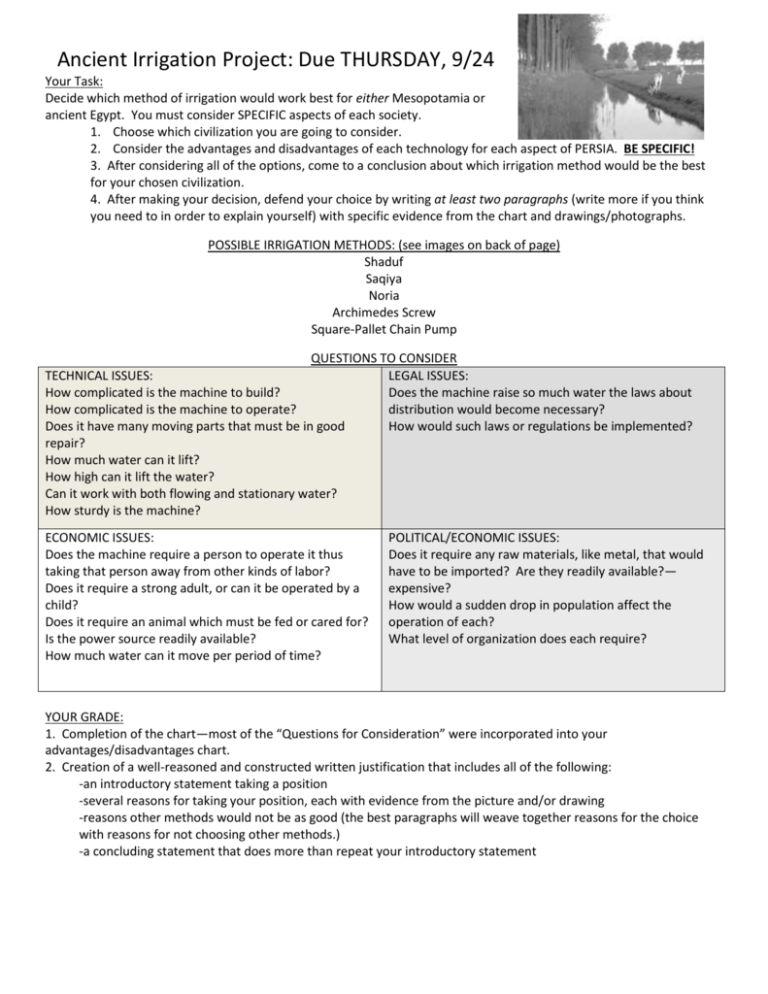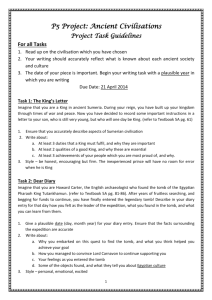Ancient Irrigation Project
advertisement

Ancient Irrigation Project: Due THURSDAY, 9/24 Your Task: Decide which method of irrigation would work best for either Mesopotamia or ancient Egypt. You must consider SPECIFIC aspects of each society. 1. Choose which civilization you are going to consider. 2. Consider the advantages and disadvantages of each technology for each aspect of PERSIA. BE SPECIFIC! 3. After considering all of the options, come to a conclusion about which irrigation method would be the best for your chosen civilization. 4. After making your decision, defend your choice by writing at least two paragraphs (write more if you think you need to in order to explain yourself) with specific evidence from the chart and drawings/photographs. POSSIBLE IRRIGATION METHODS: (see images on back of page) Shaduf Saqiya Noria Archimedes Screw Square-Pallet Chain Pump QUESTIONS TO CONSIDER TECHNICAL ISSUES: LEGAL ISSUES: How complicated is the machine to build? Does the machine raise so much water the laws about How complicated is the machine to operate? distribution would become necessary? Does it have many moving parts that must be in good How would such laws or regulations be implemented? repair? How much water can it lift? How high can it lift the water? Can it work with both flowing and stationary water? How sturdy is the machine? ECONOMIC ISSUES: Does the machine require a person to operate it thus taking that person away from other kinds of labor? Does it require a strong adult, or can it be operated by a child? Does it require an animal which must be fed or cared for? Is the power source readily available? How much water can it move per period of time? POLITICAL/ECONOMIC ISSUES: Does it require any raw materials, like metal, that would have to be imported? Are they readily available?— expensive? How would a sudden drop in population affect the operation of each? What level of organization does each require? YOUR GRADE: 1. Completion of the chart—most of the “Questions for Consideration” were incorporated into your advantages/disadvantages chart. 2. Creation of a well-reasoned and constructed written justification that includes all of the following: -an introductory statement taking a position -several reasons for taking your position, each with evidence from the picture and/or drawing -reasons other methods would not be as good (the best paragraphs will weave together reasons for the choice with reasons for not choosing other methods.) -a concluding statement that does more than repeat your introductory statement Category 5: 4: Excellent Good 3: Average 2: Below Average 1: Needs Improvement Chart: It is complete. It shows careful consideration of “Questions to Consider.” Introductory Statement-is well written, makes a clear choice to stated task. Support/Reasons: Several specific reasons for your choice are given. The reasons incorporate a variety of topics from chart. Comparison: The paragraph includes several areas of comparison as to why you chose or did not choose a specific system. Conclusion: The concluding sentences are well written and thoughtful. DIRECTIONS: Create this chart as many times as needed on a separate page to assess advantages and disadvantages of each irrigation method. Fill out this chart for the one you choose so you can hand it in for a grade. ADVANTAGES Political Economic Religious Social Interaction with the Environment Achievements DISADVANTAGES IRRIGATION TECHNOLOGY OPTIONS: Saqiya (Sakleah) Shaduf Shaduf, also spelled Shadoof, hand-operated device for lifting water, invented in ancient times and still used in India, Egypt, and some other countries to irrigate land. Typically it consists of a long, tapering, nearly horizontal pole mounted like a seesaw. A skin or bucket is hung on a rope from the long end, and a counterweight is hung on the short end. The operator pulls down on a rope attached to the long end to fill the bucket and allows the counterweight to raise the bucket. To raise water to higher levels, a series of shadufs are sometimes mounted one above the other. In India the device is called a denkli, or paecottah. http://www.britannica.com/EBchecked/topic/537571/shaduf Sakia, also spelled sakieh, Arabic sāqīyah, also called Persian wheel, mechanical device used to raise water from wells or pits. A sakia consists of buckets fastened to a vertical wheel or to a rope belt about the wheel, which is itself attached by a shaft to a horizontal wheel turned by horses, oxen, or asses. Sakias made of metal, wood, and stone are found throughout the Middle East, especially in Egypt, where they provide the steady streams of water required for irrigation. Historically, they have also been used in palaces and gardens to fill fountains. Earthen pots used as sakia buckets, identified by fastening knobs and by marks from rubbing against the wheels, guard rods, or walls of wells, have been dated to the 2nd century ad. http://www.britannica.com/EBchecked/topic/518730/sakia Archimedes Screw Archimedes screw, machine for raising water, allegedly invented by the ancient Greek scientist Archimedes for removing water from the hold of a large ship. One form consists of a circular pipe enclosing a helix and inclined at an angle of about 45 degrees to the horizontal with its lower end dipped in the water; rotation of the device causes the water to rise in the pipe. Other forms consist of a helix revolving in a fixed cylinder or a helical tube wound around a shaft. Modern screw pumps, consisting of helices rotating in open inclined troughs, are effective for pumping sewage in wastewater treatment plants. The open troughs and the design of the screws permit the passage of debris without clogging. http://www.britannica.com/EBchecked/topic/32831/Archimedesscrew Square-Pallet Chain Pump The chain pump is type of a water pump in which several circular discs are positioned on an endless chain. One part of the chain dips in to the water, and the chain runs through a tube, slightly bigger than the diameter of the discs. As the chain is drawn up the tube, water becomes trapped between the discs and is lifted to and discharged at the top. Chain pumps were used for centuries in the ancient Middle East, Europe, China, and ancient Egypt. http://en.wikipedia.org/wiki/Chain_pump Noria Noria, undershot waterwheel used to raise water in primitive irrigation systems. It was described by the Roman architect Vitruvius (c. 1st century bce). As the noria turns, pots or hollow chambers on the rim fill when submerged and empty automatically into a trough when they reach or exceed the level of the centre of the wheel. In antiquity the wheels may have been as much as 12 metres (40 feet) in diameter. Norias of the medieval period were even larger; the largest noria at Hamah, Syria, dates from 1000 ce and is 20 metres (66 feet) in diameter. The wheel-turning force of the stream was sometimes augmented by humans or animals on a connected treadmill. http://www.britannica.com/EBchecked/topic/418175/noria







